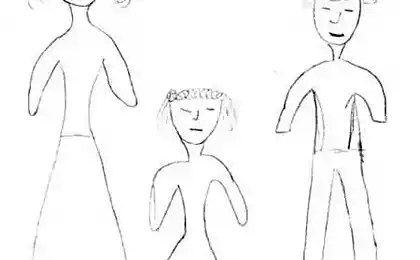686
As only 3 hours of sitting can destroy your blood vessels
More and more studies prove a significant risk of excessive seat for adults, but they are not the only ones at risk. Children spend more than 60 percent of the time during their waking hours sitting, according to some estimates, the children sit on average for 8.5 hours a day.

In addition, it is noted that after 8 years level of activity drops sharply, especially among girls. The researchers decided to study a small group of girls (aged 7 to 10 years) to determine whether the seat is hurting their health as it harms adults.
In adults, many hours of sitting leads to narrowing of the arteries in the legs, which impedes blood flow, increases blood pressure and contributes to the development of cardiovascular diseases in the long term. And the children?
Three hours continuous seat reduces the function of blood vesselsIn the beginning of the study, all girls were healthy function of the arteries. But after three hours of continuous sitting, when they were playing on the tablet or watching movies, it was noted a "profound" decrease in the function of blood vessels.
The expansion of the arteries of the girls fell by 33 percent, which is alarming, because, as you know, in adults, reducing the function of blood vessels by 1 percent increases the risk of heart disease by 13 percent.
But obtained some encouraging results. A few days later, when the girls came back to the laboratory, the function of their arteries returned to normal levels. And when while sitting the girls were doing 10-minute breaks and went on the bike, reducing the function of blood vessels was observed.

However, nobody knows how many hours of sitting, day after day affects the health of children, so it is better to encourage their physical activity.
The study's author, Dr. Ali McManus, associate Professor of pediatric sports physiology of the University of British Columbia in Kelowna, told the newspaper "The New York Times":
"The obtained results unequivocally prove that children can not sit continuously for a long time."
Alan Hedge, Professor of ergonomics at Cornell University, who was not involved in the study, adds in an interview with CNN:
"This study shows that, from the point of view of fundamental physiology of the body, children are not so different from adults... It confirms that the seat compresses blood vessels in young people as well as adults [and] as well as in the elderly".
Why you (and your children) need to try to sit less than three hours a day foran Adult, on average, 9-10 hours daily sitting is so passive that even 30-60 minutes of exercise is not enough to deal with the consequences of the seat. Perhaps sitting for so long it seems natural to you, because you grew up with this habit (physically and mentally), but in fact, this is completely contrary to our nature.
The study of life in rural areas show that people in the villages sitting a total of approximately three hours per day.
Your body is built to move and be active most of the day, but if instead most of the time you sit, there are significant negative changes.
Resource the Mind Unleashed ("Liberated mind") is especially remarkable given the description of what happens in different areas of your body after prolonged sitting.
You will be surprised, but the seat affects the entire body — from brain to toe.
Harmful to bodies
Bad for the brain
Bad for the posture
Muscle degeneration
Violation of footwork
To overcome this problem, some far-sighted schools children are allowed to move around during the day, not forcing them to sit for hours at their desks. So, in elementary school, and Vallecito in San Rafael, California, at least, in four classes set the tables to work standing up, without chairs.
After an initial transition period, the standing has received rave reviews. Students believe that such tables is "fun" and "help to concentrate". Teachers say that at these tables the children more attentive, parents add that children have a better night's sleep...
And at the same time – no risk of excessive seat! Everyone wins! Similarly, in Central high school in NAPERVILLE, Illinois, implemented a special program – students can take classes dynamic physical education at the beginning of the day and throughout the day in their classrooms can go on the bicycles and balls.
Participants in this program is almost two times increased academic performance in reading and mathematics in 20 times. The results speak for themselves... and for the adults they also apply. If you work in an office, one of the best ways to reduce seat time to get a table for working while standing.
In a study published in the journal "Preventive medicine" analyzed 23 studies of such tables and found that they reduce the seat time, and improve mood.
An additional advantage of the use of tables for working while standing are:
"When you give a man a table for working while standing, this man, as a rule, is several hours a day. But it is not in place. Something is going on. First, he shifts from one foot to the other and, in General, quite a lot and often changes the position of the body.
This work with weight and its adjustment has a number of physiological benefits to muscles, her balance, for the visual cortex, testicular system and so forth."
Even movements such as fidgeting, useful. Women who according to them, sit, hardly moving, for the day of seven hours or more, the risk of mortality from all causes increased by 30 percent.
Women who, according to them, fidget more often is much more fortunate – although they sit five or six hours a day, their risk of mortality below. In addition, no reported increased risk of mortality from more time in a sitting position in the "medium" or "often" jerseysa groups.
Another example: people who set a goal each hour to stand and walk for two minutes, increased my life expectancy by 33 percent, compared to those who did not. Those who just stood for two minutes in an hour, did not receive such benefits as those who are within two minutes walking.
If you set a goal to do between 7,000 and 10,000 steps a day (which is about 6-9 kilometers), you will get much more traffic and greatly reduce seat time. It will surpass any set of exercises that you can do.
I personally make about 14,000 to 15,000 steps a day, which usually fit into my 90-minute walk. Tracking steps will show you how simple and seemingly minor changes in how you move at work can affect the overall situation.
To keep track of your daily steps, I recommend using a pedometer, and even better — one of the new fitness trackers that can be worn on the hand.
There are other simple ways to increase physical movement and to avoid sitting at work and elsewhere:
Researchers are very surprised by the fact how easy they have made, so the girls sat there for three hours; they thought that it will be hard but the girls were even happy to oblige.
As parents, you should set limits on "screen time" for the child and encouraged not only to organized sports competitions and other events (e.g., dance classes), and regular active play and participation in household chores — walk the dog, take out the garbage, rake the leaves, etc.
If your child is a high school student can talk to teachers about how time in school to do more active. Games in the fresh air, the standing classes at the gym, as well as providing access to exercise bikes and balls for fitness are just a few examples.
In addition, it is imperative that you, yourself, were a role model – you also need to be active. If children see you constantly in motion, that you do not sit in place, they will naturally follow suit.published
© Dr. Joseph Mercola
P. S. And remember, only by changing their consumption — together we change the world! ©
Source: russian.mercola.com/sites/articles/archive/2016/08/12/%D1%87%D1%80%D0%B5%D0%B7%D0%BC%D0%B5%D1%80%D0%BD%D0%BE%D0%B5-%D1%81%D0%B8%D0%B4%D0%B5%D0%BD%D0%B8%D0%B5.aspx

In addition, it is noted that after 8 years level of activity drops sharply, especially among girls. The researchers decided to study a small group of girls (aged 7 to 10 years) to determine whether the seat is hurting their health as it harms adults.
In adults, many hours of sitting leads to narrowing of the arteries in the legs, which impedes blood flow, increases blood pressure and contributes to the development of cardiovascular diseases in the long term. And the children?
Three hours continuous seat reduces the function of blood vesselsIn the beginning of the study, all girls were healthy function of the arteries. But after three hours of continuous sitting, when they were playing on the tablet or watching movies, it was noted a "profound" decrease in the function of blood vessels.
The expansion of the arteries of the girls fell by 33 percent, which is alarming, because, as you know, in adults, reducing the function of blood vessels by 1 percent increases the risk of heart disease by 13 percent.
But obtained some encouraging results. A few days later, when the girls came back to the laboratory, the function of their arteries returned to normal levels. And when while sitting the girls were doing 10-minute breaks and went on the bike, reducing the function of blood vessels was observed.

However, nobody knows how many hours of sitting, day after day affects the health of children, so it is better to encourage their physical activity.
The study's author, Dr. Ali McManus, associate Professor of pediatric sports physiology of the University of British Columbia in Kelowna, told the newspaper "The New York Times":
"The obtained results unequivocally prove that children can not sit continuously for a long time."
Alan Hedge, Professor of ergonomics at Cornell University, who was not involved in the study, adds in an interview with CNN:
"This study shows that, from the point of view of fundamental physiology of the body, children are not so different from adults... It confirms that the seat compresses blood vessels in young people as well as adults [and] as well as in the elderly".
Why you (and your children) need to try to sit less than three hours a day foran Adult, on average, 9-10 hours daily sitting is so passive that even 30-60 minutes of exercise is not enough to deal with the consequences of the seat. Perhaps sitting for so long it seems natural to you, because you grew up with this habit (physically and mentally), but in fact, this is completely contrary to our nature.
The study of life in rural areas show that people in the villages sitting a total of approximately three hours per day.
Your body is built to move and be active most of the day, but if instead most of the time you sit, there are significant negative changes.
Resource the Mind Unleashed ("Liberated mind") is especially remarkable given the description of what happens in different areas of your body after prolonged sitting.
You will be surprised, but the seat affects the entire body — from brain to toe.
Harmful to bodies
- Heart: when you sit, blood flows slower, and your muscles burn less fat, allowing fatty acids to clog the heart. A study published in the "Bulletin of the American College of cardiology" showed that women who sit more than 10 hours a day significantly increases the risk of cardiovascular disease, compared to those who spends sitting not more than five hours.
- Pancreas: just a day excessive sitting, and your body's ability to respond to insulin decreases, causing the pancreas produces it in large amounts. And this can lead to diabetes.
- Colon cancer: excessive sitting increases the risk of developing cancer of the colon, breast and endometrium. This mechanism has not been clarified until the end, but perhaps it is associated with excess insulin production, which stimulates the growth of cells, or the fact that the regular movement increases the level of antioxidants in the body, capable of eliminating potentially carcinogenic free radicals.
- Digestive system: when eating, you sit down, the contents of the abdomen is compressed, slowing digestion. Sluggish digestion, in turn, can lead to spasms, bloating, heartburn and constipation, as well as disbioza the gastrointestinal tract (this condition occurs due to the imbalance of microbes in the body).
Bad for the brain
- When the body is too long in a sitting position, slowing down brain function. The brain will receive less fresh blood and oxygen necessary to start the release of chemicals that improve its performance and enhance mood.
Bad for the posture
- Tension neck and shoulders: usually when you work at a computer or holding the phone with your ear, you cant forward the neck and head. This can lead to deformation of the cervical vertebrae, and constant disequilibrium can cause stretching of the neck, aching pain in the shoulders and back.
- Back problems: in the sitting position, the spine is experiencing more pressure than in the standing position, but if you sit hunched before the computer, you'll do more damage to the health of the back. An estimated 40 percent of people with back pain daily for a long time working at the computer.
Muscle degeneration
- The standing position requires you of the tension of the abdominal muscles, which in the sitting position are not used and eventually become weak.
- Problems with the hips: the hips also suffer from prolonged sitting — they become tense, and their range of motion is limited because they are rarely stretched. The elderly reducing the possibility of motion of the hip is a major cause of falls.
- The seat also does nothing good for the gluteal muscles, which become weakened and it affects your resistance and strength of the step during walking and jumping.
Violation of footwork
- Varicose veins: because the seat interferes with the circulation of blood in the legs, causing ankle swelling, varicose veins and the appearance of blood clots, otherwise a deep vein thrombosis (DVT).
- Weak bones: walking, Jogging and doing other types of strength activities helps bones become stronger and more dense. The lack of activity can cause weak bones and even osteoporosis.
To overcome this problem, some far-sighted schools children are allowed to move around during the day, not forcing them to sit for hours at their desks. So, in elementary school, and Vallecito in San Rafael, California, at least, in four classes set the tables to work standing up, without chairs.
After an initial transition period, the standing has received rave reviews. Students believe that such tables is "fun" and "help to concentrate". Teachers say that at these tables the children more attentive, parents add that children have a better night's sleep...
And at the same time – no risk of excessive seat! Everyone wins! Similarly, in Central high school in NAPERVILLE, Illinois, implemented a special program – students can take classes dynamic physical education at the beginning of the day and throughout the day in their classrooms can go on the bicycles and balls.
Participants in this program is almost two times increased academic performance in reading and mathematics in 20 times. The results speak for themselves... and for the adults they also apply. If you work in an office, one of the best ways to reduce seat time to get a table for working while standing.
In a study published in the journal "Preventive medicine" analyzed 23 studies of such tables and found that they reduce the seat time, and improve mood.
An additional advantage of the use of tables for working while standing are:
- The increase in heart rate of approximately eight beats per minute, and the use of tables with treadmill increases it by 12 beats per minute
- Increases the level of HDL (good) cholesterol
- Weight loss in three months of using the table for working while standing
- The people who work at the tables standing up, rarely complain of fatigue, tension, confusion and depression; they are often cheerful, full of energy, focused and happy.
"When you give a man a table for working while standing, this man, as a rule, is several hours a day. But it is not in place. Something is going on. First, he shifts from one foot to the other and, in General, quite a lot and often changes the position of the body.
This work with weight and its adjustment has a number of physiological benefits to muscles, her balance, for the visual cortex, testicular system and so forth."
Even movements such as fidgeting, useful. Women who according to them, sit, hardly moving, for the day of seven hours or more, the risk of mortality from all causes increased by 30 percent.
Women who, according to them, fidget more often is much more fortunate – although they sit five or six hours a day, their risk of mortality below. In addition, no reported increased risk of mortality from more time in a sitting position in the "medium" or "often" jerseysa groups.
Another example: people who set a goal each hour to stand and walk for two minutes, increased my life expectancy by 33 percent, compared to those who did not. Those who just stood for two minutes in an hour, did not receive such benefits as those who are within two minutes walking.
If you set a goal to do between 7,000 and 10,000 steps a day (which is about 6-9 kilometers), you will get much more traffic and greatly reduce seat time. It will surpass any set of exercises that you can do.
I personally make about 14,000 to 15,000 steps a day, which usually fit into my 90-minute walk. Tracking steps will show you how simple and seemingly minor changes in how you move at work can affect the overall situation.
To keep track of your daily steps, I recommend using a pedometer, and even better — one of the new fitness trackers that can be worn on the hand.
There are other simple ways to increase physical movement and to avoid sitting at work and elsewhere:
- Organization location office space so that you had to get up for folders that you use often, phone, or printer, and do not keep them on hand.
- Instead of a chair to use a fitness ball. Unlike sitting in a chair, sitting on the ball activates the muscles of the body and helps to improve balance and flexibility. Periodic Bouncing helps the body interact with gravity to a greater extent than sitting on a stationary chair. But it is, in fact, a concession, and still the seat, so the best option is to stand.
- Alternatively, you can use vertical wooden chair without armrests, which will make you sit up straight and frequently change the body position than the cozy office chair.
- Install a timer that will remind you to get up and move at least two to 10 minutes every hour. Unable to walk, stand or take the opportunity to do a few simple exercises without leaving your Desk, for example those which we described above.
Researchers are very surprised by the fact how easy they have made, so the girls sat there for three hours; they thought that it will be hard but the girls were even happy to oblige.
As parents, you should set limits on "screen time" for the child and encouraged not only to organized sports competitions and other events (e.g., dance classes), and regular active play and participation in household chores — walk the dog, take out the garbage, rake the leaves, etc.
If your child is a high school student can talk to teachers about how time in school to do more active. Games in the fresh air, the standing classes at the gym, as well as providing access to exercise bikes and balls for fitness are just a few examples.
In addition, it is imperative that you, yourself, were a role model – you also need to be active. If children see you constantly in motion, that you do not sit in place, they will naturally follow suit.published
© Dr. Joseph Mercola
P. S. And remember, only by changing their consumption — together we change the world! ©
Source: russian.mercola.com/sites/articles/archive/2016/08/12/%D1%87%D1%80%D0%B5%D0%B7%D0%BC%D0%B5%D1%80%D0%BD%D0%BE%D0%B5-%D1%81%D0%B8%D0%B4%D0%B5%D0%BD%D0%B8%D0%B5.aspx
What kitchen products from Gipfel deserves the most attention from your side?
They do not need anything to take! Allow children to remain CHILDREN!























